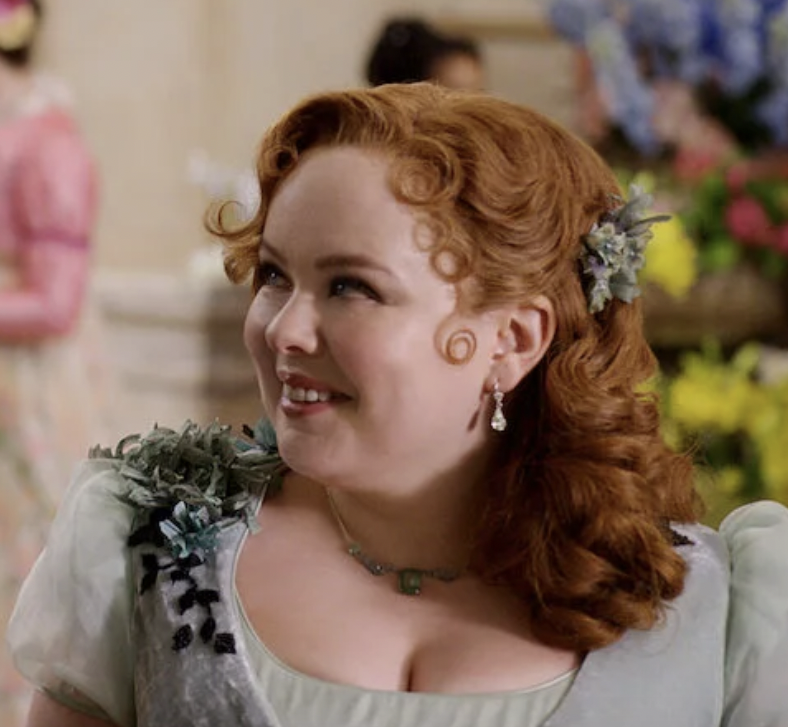
Bridgerton is back, and slowly but surely making its way down the alphabetical line of siblings (Anthony, Benedict, Colin and so on). Season three is about the third son, Colin who, no matter how quizzically he manages to arch an eyebrow, is simply not an exciting character. In season one Colin was a soft-spoken boy who nobody noticed except his sister’s wallflower friend. Here, Colin is played (unsuccessfully) as a rake. He is neither good-looking nor suave enough to pull it off. Mysteriously, he is the object of many young ladies’ attentions, and he’s slept with more French women than he can remember. With so many women after him, how could a wallflower hope to compete? That is the central question of Bridgerton’s third season, with Penelope Featherington as the unlikely leading lady. Her prominence was a surprise to many, not least because Penelope (though acted very well by Nicola Coughlan, ie Clare from Derry Girls,) does not look like a leading lady. She looks like a wallflower. Much criticism has been launched at the new season for casting an overweight actress as the romantic lead. It’s inclusivity gone beyond the bounds of commercial television, they say. ‘How could young Colin ever fall in love with her?’ they ask. Frankly I can’t see how anyone could fall in love with Colin, but that’s beside the point. The real reason Penelope is not a good leading lady is that she already has a smashing role; for as we found out at the end of season one, homely old Penelope is behind the devilishly prolific gossip columnist Lady Whistledown. From her, no Mayfair secrets are safe. But Lady Whistledown can’t fall in love. She’s far too worldly for that.
Nevertheless, Penelope emerges from the shadows, turning unpleasantly into a simpering, self-pitying sad sack. She steps away from the wall to join the flock of every other eligible young lady prostrating themselves in front of minor aristocrats. When Penelope’s not sidling up to men at the lemonade table she’s complaining to her crush that no one pays attention to her—not a good look. If she wants to win Colin’s heart she’ll have to nip that in the bud. Then she meets the eccentric yet charming Lord Debling, a nature enthusiast who bemoans the dead stuffed animals on display throughout Mayfair’s ballrooms. He’ll do. Shockingly (to Penelope) she seems to fit the bill for him too, and a proposal seems eminent. But then love gets in the way again. Pen still loves Colin. Does he love her? Not likely. And yet…
Ever since another man showed interest in Penelope, Colin keeps falling into feverish dreams in which he gets off with her in dark corners of the garden. This is about as much steamy material as we get this time, which suits me just fine. Since Colin’s dreams seem to point him towards her, Pen may have to decide between Lord Debling and him: practicality, or passion. Which will she choose? This is Bridgerton so we already know. By its third outing the Bridgerton formula is wearing. It was slightly shocking in season one when Regency costumes started falling to the floor. Season two was lacklustre, and season three feels contrived. Even the characters tire of attending endless balls and social gatherings (‘Can’t we just stay home tonight, darling?’), and boy was I tired of watching them. One thing one should never be bored of in a Regency rom com is social gatherings, but there really is nothing else on offer.
Apart from the romps amid the mahogany bookshelves, Bridgerton’s main attractions are the sets and costumes. They are the stars, with the hairpieces growing in size and absurdity in each new episode. At one ball the queen wears a wig which contained a rotating scene inside it, like the kinds you see at garden centres in children’s Christmas displays. Queen Charlotte herself has little dialogue, but uses most of her screen time smirking and curling her lip at the underwhelming batch of debutantes. And Queen Charlotte is the character whom Netflix decided was interesting enough to merit her own spin-off series. I haven’t seen it so I can’t comment further. The only good characters in Bridgerton season three are the other older women at the top of Mayfair’s social circle; Polly Walker, having a ball as the conniving Lady Featherington; Ruth Gemmell as sweet and eager Lady Bridgerton, and the imposing Adjoa Andoh as the power behind the throne, Lady Danbury. These women are expressive and fun, unlike everyone else. And the music. Season two ended in a bewildering string-quartet cover of Miley Cyrus’s Wrecking Ball. That was the lead couple’s final dance. Even in the modern milieu of Bridgerton, Miley Cyrus is too far. Season three reaches a new low—it’s boring, and in the world of escapism TV, boring is unforgivable.

